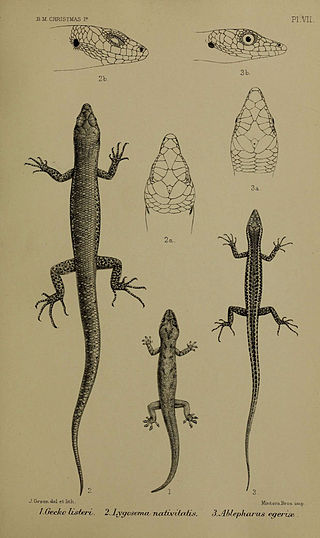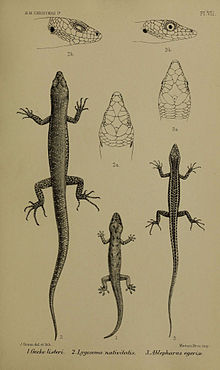
Threatened fauna of Australia are those species and subspecies of birds, fish, frogs, insects, mammals, molluscs, crustaceans, and reptiles to be found in Australia that are in danger of becoming extinct. This article lists species classified as threatened species under the Commonwealth Environment Protection and Biodiversity Conservation Act 1999.
The Christmas Island blind snake is a species of snake in the family Typhlopidae. The species is endemic to Christmas Island. There are no subspecies that are recognized as being valid.

Leo Daniel Brongersma was a Dutch zoologist, herpetologist, author, and lecturer.

The coastal snake-eyed skink or supralittoral shinning-skink is a small skink found in North Queensland, Australia and New Guinea.

Lepidodactylus listeri, also known commonly as Lister's gecko or the Christmas Island chained gecko, is a species of gecko, a lizard in the family Gekkonidae, endemic to Christmas Island in the Indian Ocean. It is currently extinct in the wild.

Christmas Island National Park is a national park occupying most of Christmas Island, an Australian territory in the Indian Ocean southwest of Indonesia. The park is home to many species of animal and plant life, including the eponymous red crab, whose annual migration sees around 100 million crabs move to the sea to spawn. Christmas Island is the only nesting place for the endangered Abbott's booby and critically endangered Christmas Island frigatebird, and the wide range of other endemic species makes the island of significant interest to the scientific community.

Cryptoblepharus australis, commonly called the inland snake-eyed skink, is a species of skink in the genus Cryptoblepharus.

Cryptoblepharus egeriae, also known commonly as the blue-tailed shinning-skink, the Christmas Island blue-tailed shinning-skink, and the Christmas Island blue-tailed skink, is a species of lizard in the family Scincidae that was once endemic to Christmas Island. The Christmas Island blue-tailed skink was discovered in 1888. It was formerly the most abundant reptile on the island, and occurred in high numbers particularly near the human settlement. However, the Christmas Island blue-tailed skink began to decline sharply outwardly from the human settlement by the early 1990s, which coincided with the introduction of a predatory snake and the introduction of the yellow crazy ant in the mid-1980s. By 2006, the Christmas Island blue-tailed skink was on the endangered animals list, and by 2010 the Christmas Island blue-tailed skink was extinct in the wild. From 2009 to 2010, Parks Australia and Taronga Zoo started a captive breeding program, which has prevented total extinction of the species.

The Christmas Island forest skink, also known as the Christmas Island whiptail skink, is a species of skink formerly endemic to Australia's Christmas Island. As of 2017, it is listed as extinct on the IUCN Red List. The last known forest skink, a captive individual named Gump, died on 31 May 2014.
Cryptoblepharus cygnatus, also known commonly as Swanson's snake-eyed skink, is a species of lizard in the family Scincidae. The species is endemic to the Northern Territory in Australia.
Cryptoblepharus daedalos, also known commonly as the dappled snake-eyed skink, is a species of lizard in the family Scincidae. The species is endemic to the Northern Territory in Australia.
Cryptoblepharus gurrmul, also known commonly as the Arafura snake-eyed skink, is a species of lizard in the family Scincidae. The species is endemic to the Northern Territory in Australia.
Cryptoblepharus mertensi, also known commonly as Merten's snake-eyed skink, is a species of lizard in the family Scincidae. The species is endemic to the Northern Territory in Australia.
Cryptoblepharus wulbu, also known commonly as the spangled snake-eyed skink, is a species of lizard in the family Scincidae. The species is endemic to the Northern Territory in Australia.
Cryptoblepharus xenikos is a species of lizard in the family Scincidae. The species is endemic to Papua New Guinea.
The intermediate bandy-bandy is a species of snake in the family Elapidae.
The Northern bandy bandy is a species of snake in the family Elapidae.







